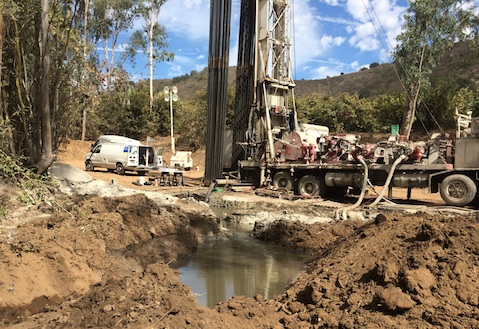Report Analyzes Goleta Gas-Out
Facts Made Public on Hydrogen Sulfide Spill that Sickened Many in October

The mea culpas flow thick and humbly throughout the county Office of Emergency Management (OEM) wrap-up of the Ellwood Canyon hydrogen sulfide release last October, and the agencies involved are changing procedures and buying equipment to avoid a repeat of the delayed public notice. But western Goleta residents downwind of the release, who have stewed for three months over the incident, want more to be done, they told the Goleta City Council on January 17.
Hydrogen sulfide (H2S) is the Slenderman of the drilling world. A breath or two can kill at 700-1,000 parts per million (ppm). The drillers, an outfit from New Mexico, were just outside city borders, putting in an agricultural well on October 9, 2016. They were down to 3,250 feet when they hit a pocket of H2S around 4 a.m. Their personal detection monitors registered a low level of H2S, 10-15 ppm, they later told a county Environmental Health Services inspector, but that morning they didn’t report it to the state or the county. Their permit didn’t explicitly require it, though state law does.
The heavy gas had rolled to the Ellwood Bluffs less than an hour later, awakening Mark Kram, a hydrogeologist who has worked in the oil fields and lives at the Hideaway, about two miles from the well site. It also registered on the fence-line monitors at Venoco’s Ellwood Onshore Facility, about half a mile west of Kram’s home, which sent an automatic email notification to the Air Pollution Control District that Sunday morning.
As about half a dozen people did that day, Kram called Fire Station 11 on Storke Road about the noxious smell. The engine crew took their four-gas monitor out six times that day to try to find the source, finally getting a fix on it 16 hours later because wind conditions were right and a Winchester Circle resident had called. All day, worried residents had emailed each other, written NextDoor posts, and contacted the county CEO’s office, under which OEM operates. It was more than 24 hours before the first public notification went out.
A good number of his neighbors contacted Kram, knowing of his expertise and also that he runs a software company that maps gas monitor information. Within a half hour of calling County Fire, Kram had evacuated with his wife, who had developed a headache, and their dogs. People told him they had nosebleeds. “I told them it was up to them, but that we had left,” he told The Independent.
Invisible and heavier than air, hydrogen sulfide collects in enclosed spaces and low spots, which is where most reported deaths occur. Trace amounts, as little as 0.01 ppm, of hydrogen sulfide carry a distinctive sulfur or rotten egg smell according to OSHA, though the gas has a pernicious ability to knock out the sense of smell at about 100 ppm. The state has put the ambient air quality level for H2S at 0.03ppm for public health and odor nuisance, with 100 ppm an “immediate danger” level. The fence-line monitors at Venoco registered a high of 3.6ppm between October 9 and 11. H2S has not been classified as a carcinogen, according to the U.S. Department for Health and Human Services, but spontaneous abortion is listed among the reproductive effects that have not been ruled out for chronic exposure.
All fingers pointed to Venoco in the early hours of the incident. But none of Venoco’s interior monitors at the EOF registered the gas. Speakers at the Goleta Council asked why the outside monitor up Hollister Avenue from the EOF, lost in a turnover of property owners, was never replaced. But Mark Kram thinks that monitor is only one in a series that are needed to protect the community from accidental releases, whether from the oil plant or water wells. “There’s a group of students at UCSB,” he said, “who are working on a grant to set up a system of monitors.”
The well permitting agency, which is part of County Public Health, is putting together a notice to drillers to detail how hydrogen sulfide releases must be reported. A call to county dispatch by the property owner or the drillers would have alerted authorities immediately, many pointed out at the Goleta Council meeting. According to Larry Fay, director of Environmental Health Services — an agency absent from the meeting, as Councilmember Michael Bennett criticized — if County Counsel approves the new language, it should be a permit requirement by mid-February.



